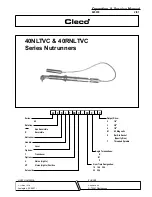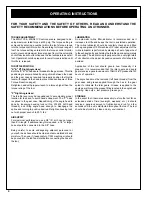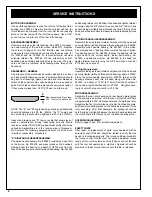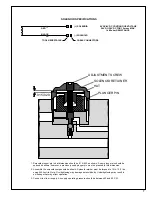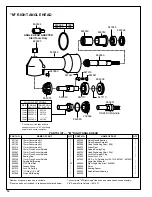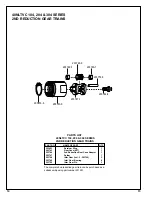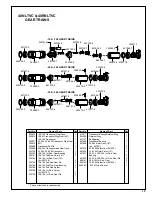
2
For your safety and the safety of others, read and understand the safety
recommendations and operating instructions before operating a
nutrunner.
Always wear protective equipment:
For additional information on eye protection and face protection, refer
to Federal OSHA Regulations, 29 Code of Federal Regulations,
Section 1910.133., Eye and Face Protection, and American National
Standards Institute, ANSI Z87.1, Occupational and Educational Eye
and Face Protection. Z87.1 is available from the American National
Standards Institute, Inc., 11 West 42nd Street, New York, NY 10036.
Hearing protection is recommended in high noise areas 85 dBA or
greater. The operation of other tools and equipment in the area,
reflective surfaces, process noises and resonant structures can
substantially contribute to, and increase the noise level in the area.
Excessive air pressure above 90 PSIG or worn motor components can
also increase sound level emitted by tool. Proper hearing conservation
measures, including annual audiograms and training in the use and fit
of hearing protection devices may be necessary. For additional infor-
mation on hearing protection, refer to Federal Regulations, Section
1910.95, Occupational Noise Exposure, and American National Stan-
dards Institute, ANSI S12.6, Hearing Protectors.
Cleco nutrunners are designed to operate on 90 psig (6.2 bar) maxi-
mum air pressure. If the tool is properly sized and applied, higher air
pressure is unnecessary. Excessive air pressure increases the loads
and stresses on the tool parts, sockets, and fasteners and may result
in breakage. Installation of a filter-regulator-lubricator in the air supply
line ahead of the tool is recommended.
Before the tool is connected to the air supply, check the throttle for
proper operation (i. e., throttle moves freely and returns to closed
position). Being careful not to endanger adjacent personnel, clear the
air hose of accumulated dust and moisture. Before connecting a tool
to the air hose, removing a tool from service or changing sockets, make
sure the air line is shut off and drained of air. This will prevent the tool
from operating if the throttle is accidently engaged.
When using right angle nutrunners, be sure the throttle is positioned
relative to the angle head so that the throttle will not become wedged
against an adjacent object in the "ON" position due to torque reaction.
The angle head may be repositioned with respect to the lever to
accommodate proper location for task. Refer to operating instructions
for additional information.
Safety Recommendations
It is essential for safe operation that any operator of a nutrunner use
good balance, sure footing, and proper posture in anticipation of a
torque reaction.
The torque setting entered into the torque control monitor must not
exceed maximum torque range of tool, or tool will stall and not shut-off.
Operator must then resist stall torque until throttle is released.
Tool balance arms are available to absorb the torque reaction of the tool
while balancing the weight of the tool for improved ergonomic applica-
tions.
Some individuals may be susceptible to disorders of the hands and
arms when performing tasks consisting of highly repetitive motions
and/or exposure to extended vibration. Cumulative trauma disorders
such as carpal tunnel syndrome and tendonitis may be caused or
aggravated by repetitious, forceful exertions of the hands and arms.
Vibration may contribute to a condition called Raynaud's Syndrome.
These disorders develop gradually over periods of weeks, months, and
years. It is presently unknown to what extent exposure to vibrations or
repetitive motions may contribute to the disorders. Hereditary factors,
vasculatory or circulatory problems, exposure to cold and dampness,
diet, smoking and work practices are thought to contribute to the
conditions.
Any tool operator should be aware of the following warning signs and
symptoms so that a problem can be addressed before it becomes a
debilitating injury. Any user suffering prolonged symptoms of tingling,
numbness, blanching of fingers, clumsiness or weakened grip, noctur-
nal pain in the hand, or any other disorder of the shoulders, arms,
wrists, or fingers is advised to consult a physician. If it is determined
that the symptoms are job related or aggravated by movements and
postures dictated by the job design, it may be necessary for the
employer to take steps to prevent further occurrences. These steps
might include, but are not limited to, repositioning the workpiece or
redesigning the workstation, reassigning workers to other jobs, rotating
jobs, changing work pace, and/or changing the type of tool used so as
to minimize stress on the operator. Some tasks may require more than
one type of tool to obtain the optimum operator/tool/task relationship.
The following suggestions will help reduce or moderate the effects of
repetitive work motions and/or extended vibration exposure:
WARNING
!
Impact resistant eye protection
must be worn while operating
or working near this tool.
CAUTION
!
Personal hearing protection is
recommended when operating
or working near this tool.
CAUTION
!
Spindle Rotation
Torque Reaction
Repetitive work motions and/or vibration
may cause injury to hands and arms.
Use minimum hand grip force consistent
with proper control and safe operation.
Keep body and hands warm and dry.
Avoid anything that inhibits blood circulation.
Avoid continuous vibration exposure.
Keep wrists straight.
WARNING
!
Avoid repeated bending of wrists and hands.

